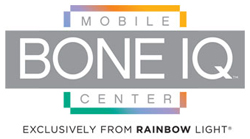Question: I have received several emails from readers in the last few months asking this question: Has the natural approach to bone health improved your bone density?
Answer: Yes, according to the bone density test I took today. Achilles Bone Ultrasonometer Results (from Rainbow Light) as of 11/3/11 are as follows: T-score: -2.6, Z-score: -1.4 (right on the border between osteopenia and osteoporosis). Compare this with the average scores from my last bone density test (Dexascan) from 11/26/08: T-score: -3.7; Z-score: -2.8 (severe osteoporosis). Bottom line: My T-score rose by an impressive 30%, and my Z-score rose by a whopping 50%. So, apparently my bones are continuing to gain density at an age when most women are losing bone density.
Am I worried about my borderline osteopenia/osteoporosis status? No. Why not?
1) I am a small-boned woman of Irish descent. Smaller bones and lighter bone density tend toward for us.
2) A few years ago, I broke my left shoulder in four places in a bike accident. The fractures healed in record time! Apparently, my bone-building mechanism works fine.
3) I recently took a hard fall while training for a 5K race, which resulted in a massage for sore muscles and a chiropractic adjustment for my spine, but no broken bones.
4) I now scan once a month on a NES ProVision body-field scanner. If I am low on particular vitamins or minerals, such as calcium, magnesium, or Vitamin D, that information shows up on the scan report. I immediately take action. Last month my calcium level was low, as were some other minerals, so I started taking Garden of Life’s “Grow Bone System” for the month. My calcium level is now back to normal. Also, there is more to bone strength than bone density; in fact, it is possible to have highly dense bones than are brittle and break easily. Research shows that other minerals, such as strontium, also promote bone density and flexibility.
So, I will continue the plan:
- Eat an 80% alkaline, 20% acid diet.
- Test the pH level of my urine and saliva at least once a week, using pH testing tape, to ensure that my body is maintaining an alkaline pH level (above 7.0).
- Enjoy 20 minutes of sunlight on my skin daily, or supplement with Vitamin D3 when unable to get sunlight.
- Drink 6-8 glasses (48-64 oz.) of pure water every day.
- Engage in weight-bearing exercise regularly, including walking/jogging, weight training, stretching, belly dancing, yoga, yard work, rebounding (2-5 minutes per day)… and holding my grandchildren!


I would accept your “apples with apples” comparison requirement if the whole bone density argument boiled down to two particular bone locations. More to the point, what makes a DEXA scan the “gold standard” for bone density testing? The fact that it has to be done in the hospital and costs a fortune? Why not use a more economical general screening device to chart progress? Fractures of the hip and spine may be more life threatening, but bone density is a full-body condition, and fractures to the wrist, arms, shoulder, and legs are also debilitating. Yes, there can be different density numbers at different sites, but I have found that bone scans of the hand, heel, spine, and hip are generally in the same ballpark. I can take the average and come up with what, for me, is a reliable measurement of overall bone density. If you don’t want to accept that idea, it is completely up to you. The reader can make his/her own judgment.
The bottom line is what I mentioned in the article: Bone density is not the only–or even the most valid–measure of bone strength. Bone flexibility is even more important, yet science seems to have no test available to measure that. Calcium is not the only mineral needed to build strong bones, yet the medical community seems to ignore all but that one. The current list of pharmaceutical drugs that claim to build bone density interrupt the natural formation of bone and contribute to increased brittleness of bone in the long term, and may cause bone destruction in the jaw, knee, shoulder, and hip, as well as causing kidney damage.
I like the Ultrasonometer for documenting bone density. It’s quick and easy to use, is economical, does not subject me to radiation, and gives a good ballpark figure that you yourself said was used to determine the “need” for a DEXA scan. I choose to stop there: with the Ultrasonometer test, for charting my progress. And I choose to follow the OsteoDiet plan including diet, pH testing, sunlight, water, and weight-bearing exercise.
It is nice to see improvements, but you really need to compare apples with apples and oranges with oranges. The Ultrasonometer is not the same type of measurement as a DEXA, and you shouldn’t really compare the scores from two completely different machines. Also, doesn’t the ultrasonometer measure the heel? You need to compare the same site on your body, as there can be very different numbers for different sites. The ultrasonometer is usually used just as a general screening device, and if your scores warrant, you are advised to get a DEXA which is more accurate (and expensive). The advantage of the ultrasonometer is that it is quick, inexpensive, and does not subject the patient to radiation. However, the DEXA scan is more accurate and considered the present “gold standard” for bone density testing.
Thanks, Kathy! 🙂
Great news! Positive proof that alternative medicine works better with less side effects.